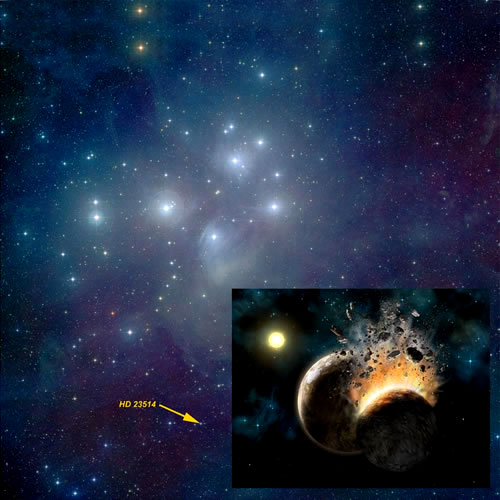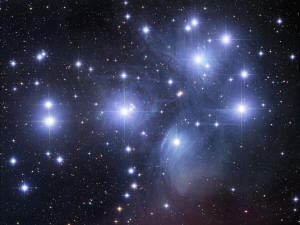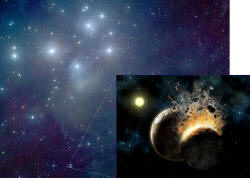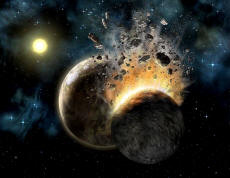|
This text will be replaced
|
Pleiades and Stardust
from
AstronomyPictureOfTheDay Website
Explanation:
Hurtling through a cosmic dust cloud a mere 400 light-years
away, the lovely Pleiades or Seven Sisters star cluster is well-known
for its striking blue reflection nebulae.
This remarkable wide-field
(3 degree) image of the region shows the famous star cluster at the
right, while highlighting lesser known dusty reflection nebulae
nearby, across an area that would span over 20 light-years.
In this
case, the sister stars and cosmic dust clouds are not related, they
just happen to be passing through the same region of space. But
astronomers using infrared detectors have recently found a dusty
disk that really does belong to one young Pleiades star - HD 23514.

Surrounding HD 23514, the disk is estimated to be comparable in size
to the terrestrial planet zone in our own solar system and likely
represents the debris from the process of rocky planet formation.
A Plethora of Planets in the
Pleiades?
Friday,
November 16, 2007
from
ProfessorAstronomy Website

Image Credit: Robert
Gendler and APOD
The Pleiades (the "Seven Sisters") are one of the most widely
recognized star clusters in the night sky. These days, they are
rising as darkness falls in the Northern Hemisphere, and are visible
most of the night. Many people mistakenly call the Pleiades the
"Little Dipper," since it kind of looks like a dipper, and it is
fairly small on the sky (about the size of the moon), but the Little
Dipper is actually elsewhere in the sky.
The Pleiades star cluster is a fairly young star cluster, as far as
astronomical ages go - it is about 125 million years old, and hasn't
even had time to orbit the Milky Way once since it formed. When the
Pleiades was young, dinosaurs like this one roamed the Earth, and,
if they had any astronomical inklings, they might have seen several
exploding stars in the young star cluster, though that excitement
has long since stopped.
Although only the seven brightest stars are visible to our eyes, the
Pleiades has at least 1500 stars, and it is frequently
the target of astronomical study, because even the faintest stars
are relatively easy for professional telescopes to see.
From the standpoint of looking for planets, the Pleiades is a great
target, Not only is it nearby, and so easy to study, but we think
the sun might have been about 100 million years old when the Earth
had finished forming in our Solar System 4.5 billion years ago. And
some evidence suggests that the Solar System was in a star cluster
when the sun formed. So, looking for evidence of forming solar
systems in the Pleiades may help us understand where we came from.
Yesterday, astronomers at UCLA announced that they have found
evidence of rocky (Earth-like) planets forming in the Pleiades.
Their evidence, from both space-based and ground observatories, is
that one star a bit bigger than our sun, called HD 23514, has a lot
of dust around it. Our sun has a lot of dust around it - most of
the dust comes from comets and asteroid collisions - but HD 23514
has a million times more dust around it than the Sun does.
Dust is a very fragile thing. Light from a star will either push
dust away or cause it to spiral into the star within a few thousand
years, so to see a ton of it around another star means that
something has happened recently to produce it. The UCLA astronomers
propose that two large planets may have collided within the last
few hundred thousand years (such a collision is what made Earth's
Moon), but it could also be that there are a lot of asteroids
around, many more than in our Solar System, and those could be
constantly colliding and grinding each other into dust.
Whatever is going on in the Pleiades, it continues to be a great
place to try and study how planets form!
Planets Forming in Pleiades Star
Cluster, Astronomers Report
by Stuart Wolpert
November 14, 2007
from
UCLA Website
Rocky terrestrial planets, perhaps like Earth, Mars or Venus, appear
to be forming or to have recently formed around a star in the
Pleiades ("seven sisters") star cluster, the result of "monster
collisions" of planets or planetary embryos.
Astronomers using the Gemini Observatory in Hawaii and the
Spitzer Space Telescope report their findings in an upcoming
issue of the Astrophysical Journal, the premier journal in
astronomy.
"This is the first
clear evidence for planet formation in the Pleiades, and the
results we are presenting may well be the first observational
evidence that terrestrial planets like those in our solar system
are quite common," said Joseph Rhee, a UCLA postdoctoral
scholar in astronomy and lead author of the research.
The Pleiades star
cluster, in the constellation Taurus, is well-known in many
cultures. It is named for the seven daughters of Atlas and
Pleione, who were placed by Zeus among the stars in Greek
mythology and is cited in the Bible,
"Can you bind the
beautiful Pleiades? Can you loose the cords of Orion?" (Job
38:31).
The automaker Subaru's
name is the Japanese word for the Pleiades, Rhee said.
The Pleiades is probably the best known star cluster and the
most striking to the naked eye.
"You've seen it many
times, and it's now easily visible in the evening sky," said
research co-author Benjamin Zuckerman, UCLA professor of
physics and astronomy.
Although referred to as
the "seven sisters," "the cluster actually contains some 1,400
stars," said co-author Inseok Song, a staff scientist at
NASA's Spitzer Science Center at the California Institute of
Technology and a former astronomer with the Gemini Observatory.
Located about 400 light-years away, the Pleiades is one of the
closest star clusters to Earth. One of the cluster's stars, known as
HD 23514, which has a mass and luminosity a bit greater than
those of the sun, is surrounded by an extraordinary number of hot
dust particles,
"hundreds of
thousands of times as much dust as around our sun," Zuckerman
said. "The dust must be the debris from a monster collision, a
cosmic catastrophe."
 
Pleiades star cluster
(composite image and artist's rendering)
November 14, 2007
Color composite
image of the Pleiades star cluster produced by Inseok Song of the
Spitzer Science Center,
using montage
software developed by IPAC/California Institute of Technology.
An artist's rendering
of a collision in the Pleiades (inset), by Lynette R. Cook, for
Gemini Observatory.
The astronomers analyzed
emissions from countless microscopic dust particles and concluded
that the most likely explanation is that the particles are debris
from the violent collision of planets or planetary embryos.
Song calls the dust particles the "building blocks of planets,"
which can accumulate into comets and small asteroid-size bodies and
then clump together to form planetary embryos, eventually becoming
full-fledged planets.
"In the process of
creating rocky, terrestrial planets, some objects collide and
grow into planets, while others shatter into dust," Song said.
"We are seeing that dust."
HD 23514 is the
second star around which Song and Zuckerman recently
have found evidence of terrestrial planet formation. They and their
colleagues reported in the journal Nature in July 2005 that a
sun-like star known as BD +20 307, located 300 light-years from
Earth in the constellation Aries, is surrounded by one million times
more dust than is orbiting our sun.
In an effort to uncover comparably dusty stars after their 2005
research, Rhee, Song and Zuckerman began
looking through thousands of publicly accessible, deep-infrared
images obtained by the Spitzer Space Telescope and soon
discovered HD 23514.
The astronomers then
used the Gemini North telescope, located on Hawaii's dormant volcano
Mauna Kea, to measure the heat radiation coming from the dust; the
heat emerges at infrared wavelengths, just as the heat from our
bodies does, Song said.
"The Gemini and
Spitzer data were crucial in identifying and establishing the
amount and location of dust around the star," Song said.
While our sun is 4.5
billion years old, the Pleiades Aries stars are "adolescents," about
100 million and 400 million years old, respectively, Rhee said.
Based on the age of the two stars and the dynamics of the orbiting
dust particles, the astronomers deduce that most adolescent sun-like
stars are likely to be building terrestrial-like planets through
recurring violent collisions of massive objects.
The cosmic debris from
only a small percentage of such collisions can be seen at any one
time — currently, only HD 23514 and BD +20 307 have visible debris.
"Our observations
indicate that terrestrial planets similar to those in our solar
system are probably quite common," Zuckerman said.
The astronomers
calculate that terrestrial planets or planetary embryos in the
Pleiades collided within the last few hundred thousand years — or
perhaps much more recently — but they cannot rule out the
possibility that multiple, somewhat smaller collisions occurred.
Many astronomers believe our moon was formed through the
collision of two planetary embryos — the young Earth and a body
about the size of Mars. That crash created tremendous debris,
some of which condensed to form the moon and some of which went into
orbit around the young sun, Zuckerman said.
By contrast, the collision of an asteroid with Earth 65 million
years ago, the most favored explanation for the final demise of the
dinosaurs, was a mere pipsqueak, he said.
"Collisions between
comets or asteroids wouldn't produce anywhere near the amount of
dust we are seeing," Song said.
HD 23514 and BD +20 307
are by far the dustiest not-so-young stars in the sky.
"Nothing else is
even close," Song said.
Very young stars — those
10 million years old or younger — may have a similar amount of dust
around them as a result of the star-formation process. However, by
the time a star is 100 million years old, this "primordial" dust has
dissipated because the dust particles get blown away or dragged onto
the star, or the particles clump together to form much larger
objects.
"Unusually massive
amounts of dust, as seen at the Pleiades and Aries stars,
cannot be primordial but rather must be the second-generation
debris generated by collisions of large objects," Song said.
The Pleiades have been
considered important by many cultures throughout history.
"To the Vikings, the
Pleiades was Freyja's hens," Rhee said.
In Bronze Age Europe,
the Celts and others associated the Pleiades with mourning and
funerals because the cluster rose in the eastern night sky between
the autumnal equinox and the winter solstice, which was a festival
devoted to the remembrance of the dead.
The ancient Aztecs of
Mexico and Central America based their calendar on the Pleiades.
The astronomers' research results are based on mid- and far-
infrared observations made with the Gemini 8-meter Frederick C.
Gillett Telescope at Gemini North and the space-based infrared
observatories Infrared Astronomical Satellite (IRAS),
Infrared Space Observatory (ISO) and NASA's Spitzer
Space Telescope.
The Gemini Observatory is an international collaboration utilizing
two identical 8-meter telescopes. The Frederick C. Gillett Gemini
Telescope is located at Mauna Kea, Hawaii (Gemini North); the other
is at Cerro Pachón in central Chile (Gemini South). Together they
provide full coverage of both hemispheres of the sky. Both
telescopes incorporate new technologies that allow large, relatively
thin mirrors under active control to collect and focus both optical
and infrared radiation from space.
UCLA is California's largest university, with an enrollment of
nearly 37,000 undergraduate and graduate students. The UCLA College
of Letters and Science and the university's 11 professional schools
feature renowned faculty and offer more than 300 degree programs and
majors. UCLA is a national and international leader in the breadth
and quality of its academic, research, health care, cultural,
continuing education and athletic programs.
Four alumni and five
faculty have been awarded the Nobel Prize.
|




